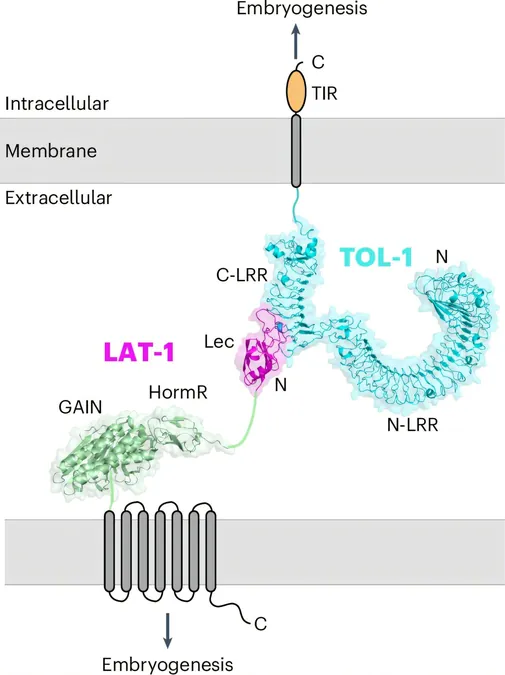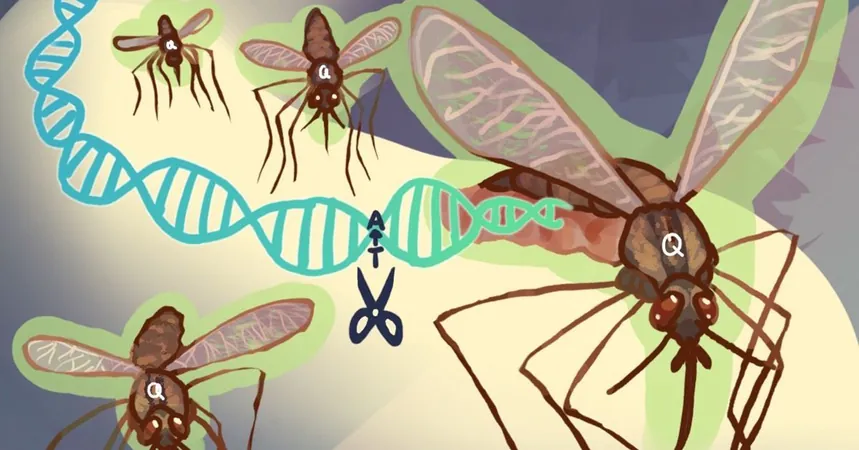
Groundbreaking Discovery Unveils Key Interactions in Embryonic Development
2025-07-01
Author: Jia
Unraveling the Mystery of Cell Communication in Embryos
The intricate dance of cell division and arrangement during animal development is a well-coordinated process critical for embryo formation. Cells rely on surface receptors to communicate, interacting with external proteins to orchestrate vital internal processes at precise times and locations. Despite our understanding of these interactions, the detailed molecular mechanics behind early embryonic communication remain shrouded in mystery.
A Novel Receptor Interaction Uncovered
Exciting new research from the University of Chicago has illuminated a previously unseen interaction between two pivotal receptors during embryonic development. One of these is latrophilin, an adhesion-type G protein-coupled receptor (aGPCR) crucial for cell adherence. The other is a toll-like receptor, commonly associated with immunity.
Utilizing a model organism, the C. elegans nematode, the research team—comprising Gabriel Carmona-Rosas, Jingxian Li, and Jayson Smith—employed biochemical, imaging, and genetic studies to explore this unique receptor interaction. Interrupting the relationship between the two receptors resulted in dramatic developmental defects, underscoring their essential roles in embryo formation and nervous system development.
The Significance of This Discovery
As senior author Dr. Engin Özkan stated, "We believe we've discovered a cell-to-cell adhesion and communication axis that ensures proper body plan formation, retaining the animal's shape and intercellular connections." This groundbreaking study has just been published in the prestigious journal Nature Structural & Molecular Biology.
High-Resolution Insights via Cryo-Electron Microscopy
The researchers captured high-resolution images using cryo-electron microscopy, revealing that latrophilin and the toll-like receptor interact in an unprecedented manner, suggesting a function beyond typical immune responses. They painstakingly mapped the complete protein structures and introduced point mutations that impeded their interaction without disrupting their other functionalities.
Significant Developmental Consequences Revealed
Engineers of developmental biology, Smith and Kratsios, used CRISPR/Cas9 to instigate these mutations within living C. elegans. The resulting embryos exhibited alarming developmental defects, with several malformed bodies—echoing the consequences of entirely knocking out the genes encoding these receptors. This evidence accentuates the critical importance of their unique interaction in embryogenesis.
Collaborative Efforts Yield Revelatory Insights
Dr. Kratsios shared his enthusiasm: "I loved this collaboration—combining high-resolution structural data with the power of C. elegans genetics yielded profound insights into latrophilin's role in development." Initially, researchers expected to see minor neuronal disruptions; however, they were astounded by the scale of developmental anomalies.
Looking to the Future of Research
Araç’s lab has spent over a decade decoding the structure of full-length aGPCRs like latrophilin, aiming to understand signal transmission from outside to inside the cell. While the nematode is a modest organism with around 1,000 cells, latrophilins are conserved across both invertebrates and vertebrates. The research team is eager to explore these receptor interactions further in vertebrates, including humans, to uncover their broader developmental and medical implications.
"This interaction might play a crucial role in vertebrates as well," Araç noted. "Our findings in this simple model organism hint at significant functions in early development, raising exciting questions about their existence in higher organisms."




 Brasil (PT)
Brasil (PT)
 Canada (EN)
Canada (EN)
 Chile (ES)
Chile (ES)
 Česko (CS)
Česko (CS)
 대한민국 (KO)
대한민국 (KO)
 España (ES)
España (ES)
 France (FR)
France (FR)
 Hong Kong (EN)
Hong Kong (EN)
 Italia (IT)
Italia (IT)
 日本 (JA)
日本 (JA)
 Magyarország (HU)
Magyarország (HU)
 Norge (NO)
Norge (NO)
 Polska (PL)
Polska (PL)
 Schweiz (DE)
Schweiz (DE)
 Singapore (EN)
Singapore (EN)
 Sverige (SV)
Sverige (SV)
 Suomi (FI)
Suomi (FI)
 Türkiye (TR)
Türkiye (TR)
 الإمارات العربية المتحدة (AR)
الإمارات العربية المتحدة (AR)